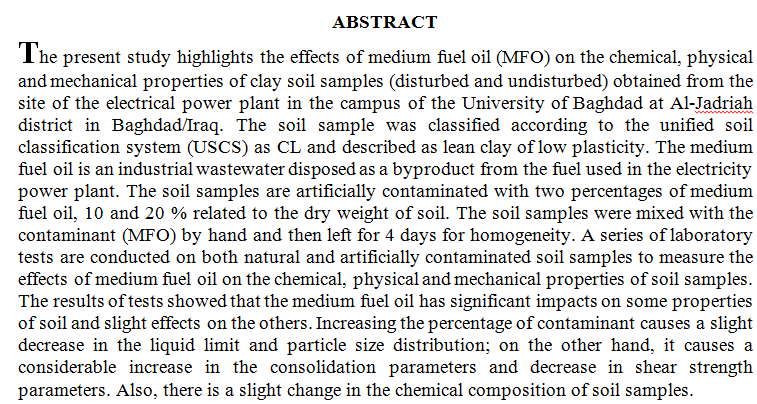
 (3)
(3)
 (4)
(4)
Pesticides serve a crucial function in contemporary farming practices, safeguarding agricultural crops against pest infestations and boosting production outputs. However, indiscriminate use has caused environmental and human health damage. This study aimed to develop and validate a gas chromatography-flame ionization detection (GC-FID) methodology for the direct and routine analysis of spiromesifen residues in soil, leaves, and tomato fruits. The proposed method prioritizes simplicity by avoiding derivatization steps, offering advantages over existing approaches that utilize lengthy multi-step extraction or derivatization prior to GC analysis. A key novelty of this work is the development of a QuEChERS extraction coupled directly to GC-FID
... Show More (1)
(1)
The effects of essential oilNigella sativa and Menthawas study on the chemical, microbial and sensory properties for soft white cheese that produced from it during storage at 0, 7 and 14 days .The results show significantly percent decrease in moisture for all samplesand maximum decrease was at the latest storage period for all them .The reduced in moisture was accompanied with increase in percentage of protein and fat during of storage period for all samples.
The control sample showed increased in bacterial logarithmic for total count bacterial, coliform, Staphylococcus aureus, proteolytic bacteria, lipolytic bacteria and mold and yeasts during of storage period , the highest results showed at the latest storage period 14days, it w
This research worked on identifying the effect of increasing the volume of indebtedness by companies listed on the Iraq Stock Exchange on the trading volume of those companies, and this research included some theoretical concepts related to both debt financing and trading volume, and it represents the research community of the joint-stock companies listed in The Iraq Stock Exchange (the banking sector). As for the research sample, it was deliberately chosen represented by companies with continuous trading without stopping, which reached 10 joint-stock companies, and the period of research was extended during the period 2011-2015, and a set of indicators and financial methods were used In measuring research v
... Show MoreSamarium ions (Sm +3), a rare-earth element, have a significant optical emission within the visible spectrum. PMMA samples, mixed with different ratios of SmCl3.6H2O, were prepared via the casting method. The composite was tested using UV-visible, photoluminescence and thermogravimetric analysis (TGA). The FTIR spectrometry of PMMA samples showed some changes, including variation in band intensity, location, and width. Mixed with samarium decreases the intensity of the CO and CH2 stretching bands and band position. A new band appeared corresponding to ionic bonds between samarium cations with negative branches in the polymer. These variations indicate complex links between the Sm +3 ion and oxygen in the ether group. The optical absorption
... Show MoreAt a temperature of 300 K, a prepared thin film of Ag doped with different ratios of CdO (0.1, 0.3, 0.5) % were observed using pulse laser deposition (PLD). The laser, an Nd:YAG in ?=1064 nm, used a pulse, constant energy of 600 mJ ,with a repetition rate of 6 Hz and 400 pulses. The effect of CdO on the structural and optical properties of these films was studied. The structural tests showed that these films are of a polycrystalline structure with a preferred orientation in the (002) direction for Ag. The grain size is positively correlated with the concentration of CdO. The optical properties of the Ag :CdO thin film we observed included transmittance, absorption coefficient, and the energy gap in the wavelength range of 300-1100
... Show More (1)
(1)
 (5)
(5)
In this article, the casting method was used to prepare poly(methyl methacrylate)/hydroxyapatite (PMMA/HA) nanocomposite films incorporated with different contents (0.5, 1, and 1.5 wt%) of graphene nanoplatelets (Gnp). The chemical properties and surface morphology of the PMMA/HA blend and PMMA/HA/Gnp nanocomposite were characterized using FTIR, and SEM analysis. Besides, the thermal conductivity, dielectric and electrical properties at (1–107 Hz) of the PMMA/HA blend and PMMA/HA/Gnp composites were investigated. The structural analysis showed that the synthesized composites had a low agglomerated state, with multiple wrinkles of graphene flakes in the PMMA/HA blend. The thermal conductivity was improved by more than 35-fold its value for
... Show More (21)
(21)
 (19)
(19)
A.C electrical conductivity and dielectric properties for poly
(vinyl alcohol) (PVA) /poly (ethylene oxide) (PEO) blends undoped
and doped with multi-walled carbon nanotube (MWCNTs) with
different concentrations (1, and 3 wt %) in the frequency range
(25x103 - 5x106 Hz) were investigated. Samples of (PVA/PEO)
blends undoped and doped with MWCNTs were prepared using
casting technique. The electrical conductivity measurements showed
that σA.C is frequency dependent and obey the relation σA.C =Aωs for
undoped and doped blends with 1% MWCNTs, while it is frequency
independent with increases of MWCNTs content to 3%. The
exponent s showed proceeding increase with the increase of PEO
ratio (≥50%) for undope
 (4)
(4)
Nanostructure of chromium oxide (Cr2O3-NPs) with rhombohedral structure were successfully prepared by spray pyrolysis technique using Aqueous solution of Chromium (III) chloride CrCl3 as solution. The films were deposited on glass substrates heated to 450°C using X-ray diffraction (XRD) shows the nature of polycrystalline samples. The calculated lattice constant value for the grown Cr2O3 nanostructures is a = b = 4.959 Å & c = 13.594 Å and the average crystallize size (46.3-55.6) nm calculated from diffraction peaks, Spectral analysis revealed FTIR peak characteristic vibrations of Cr-O Extended and Two sharp peaks present at 630 and 578 cm-1 attributed to Cr-O “stretching
... Show More (3)
(3)
